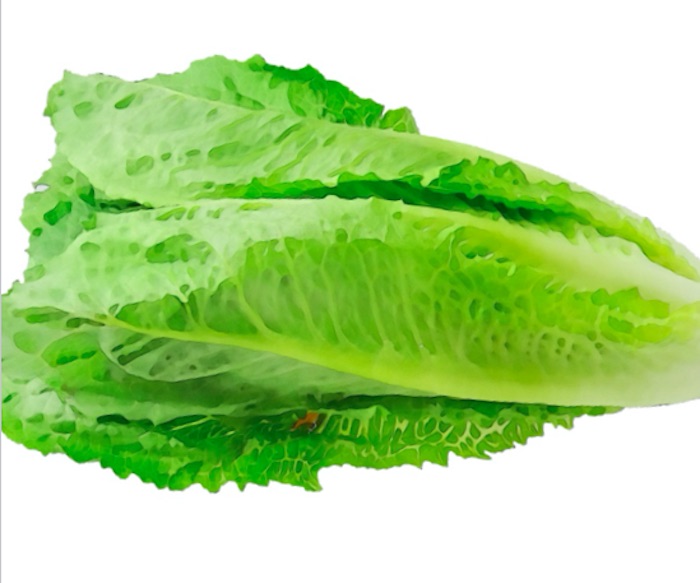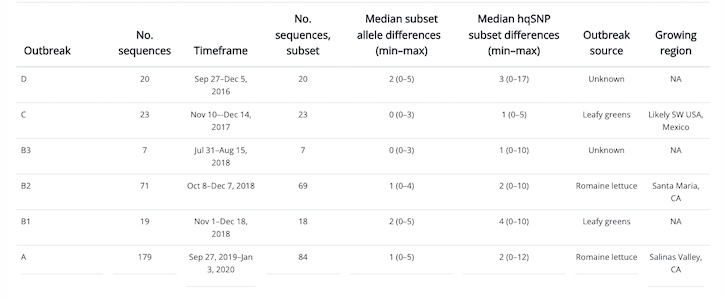Between 2016 and 2020, an E. coli strain has been linked to seven leafy greens outbreaks, according to a new study by researchers at the Centers for Disease Control and Prevention (CDC). It is now classified as a reoccurring, emerging, or persisting (REP) strain.

What is a Reoccurring, Emerging, or Persisting Strain?
Health officials use whole genome sequencing (WGS) to identify the DNA “fingerprints” of bacteria that cause foodborne illness. These fingerprints identify specific strains of bacteria. When people are sickened by the same strain, it usually means they were exposed to the same source of contamination. If outbreak patients reported eating the same food, that item and samples from the field where it was grown or the facility where it was made can also be tested using WGS.
The CDC classifies some strains of bacteria as reoccurring, emerging, or persisting (REP). Normally, outbreaks are acute, meaning there is a sharp increase in cases followed by a sharp decline until no new cases are identified and that’s the end.
But sometimes there isn’t an end to the outbreak. After the sharp decline, new cases continue to be identified, so the outbreak persists for months or years. Or, after an acute outbreak ends, the strain pops up again and causes another outbreak, so it recurs. If a strain was considered rare when it was linked to its first outbreak, but causes more illnesses or shows the potential to cause more illnesses the next time it shows up, it’s an emerging strain.
“Identifying a strain as a REP strain is based on many factors, including the number of illnesses, whether illnesses are increasing, the characteristics of the strain (e.g., multidrug resistance, high virulence, increased transmissibility), and whether the strain is the cause of large or frequent outbreaks,” according to the CDC.
In addition to REPEXH02 strain that is the subject of the new study, there are two other REP strains one is a persistent strain of Salmonella Infantis linked to chicken (REPJFX01), the other is a persistent E. coli strain linked to multiple sources including leafy greens (REPEXH01).
Outbreaks Linked to Persistent E. coli Strain
The researchers looked at six outbreaks for the study, not all of them were publically announced. They also discovered a seventh outbreak that occurred in late 2020 after Outbreak A on the chart below. Let’s call it Outbreak AA.
2020 Leafy Greens E. coli Outbreak (Outbreak AA)
Outbreak AA included 40 illnesses in 19 states. Twenty people were hospitalized, and four developed hemolytic uremic syndrome (HUS), a potentially fatal form of kidney failure associated with some E. coli infections. Health officials interviewed 23 patients about foods they ate in the week before they became ill. All but one person said they had eaten a variety of leafy greens -16 reported eating spinach, 15 said they had eaten romaine lettuce.

2020 Romine E. coli Outbreak (Outbreak A)
When this outbreak was announced in November 2019, the CDC warned consumers to avoid all romaine lettuce from Salinas, CA as health officials worked to narrow down the source of the contaminated leafy greens. But the end of the lettuce-growing season in California occurred before they could.
This romaine E. coli outbreak, which began in September 2019, sickened 167 people in 27 states before ending in January 2020. Eighty-five patients were hospitalized, 15 of them developed HUS.
The U.S. Food and Drug Administration (FDA) stated that its investigators reviewed hundreds of supply chain records and were able to narrow the origin of the implicated romaine to 10 fields in the lower Salinas Valley. The only test that was positive for the outbreak strain was taken from a sample collected from a buffer zone between a field where romaine was harvested and a cattle grazing area.
2018 Salinas-Grown Romaine from Santa Maria, (Outbreak B2)
This romaine E. coli outbreak was first announced in November 2018 and ended with 62 people sick in 16 states. Twenty-five people were hospitalized, two of them developed HUS.
One recall, from Adam Bros. Farm in Santa Barbara County, California was issued. But in the final update, the FDA said this fram did not account for all of the illnesses.
2017 Leafy Greens E. coli Outbreak
A 2017 leafy greens E. coli outbreak sickened 25 people in 15 states. Nine people were hospitalized, two developed HUS and one person died. The outbreak began in November and ended in December.
The number of cases reported from each state was: CA (4), CT (2), IL (1), IN (2), MD (3), MI (1), NE (1), NH (2), NJ (1), NY (2), OH (1), PA (2), VT (1), VA (1) and WA (1). illnesses were also reported in Canada. The FDA determined that the implicated romaine came from multiple farms in Arizona, California, and Mexico.
Contact the Pritzker Hageman E. coli Lawyers Today
Phone: 1-888-377-8900 | Text: 612-261-0856
The consultation is free and you never pay anything until we win for you.